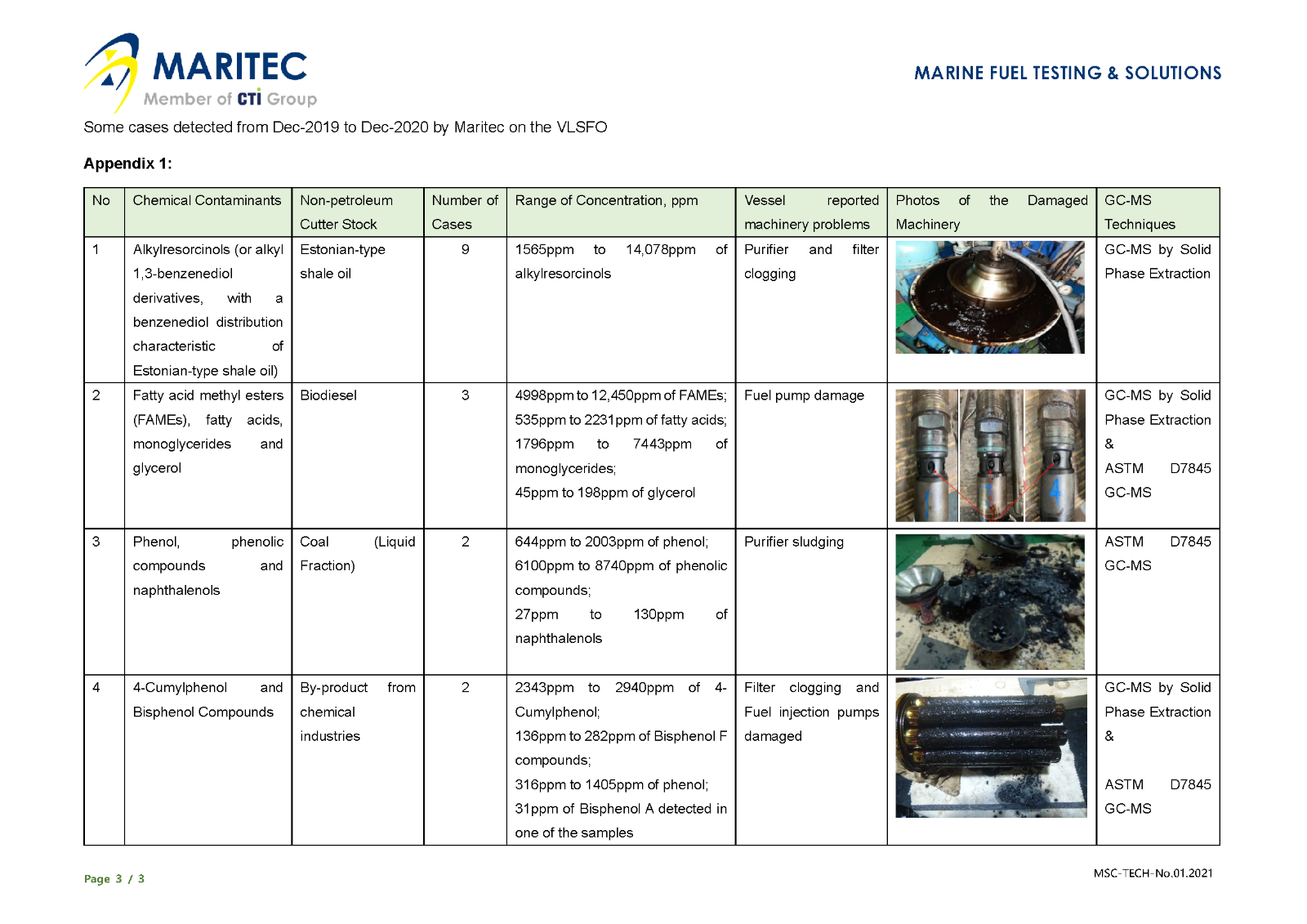新闻&资讯
相关页面
GAS CHROMATOGRAPHY-MASS SPECTROMETRY (GC-MS) AND FOURIER TRANSFORM INFRARED SPECTROSCOPY (FTIR) ANALYSIS TECHNIQUES FOR DETECTION OF CHEMICAL SPECIES IN BUNKER FUELS
One year on following the IMO 2020 sulphur cap implementation, the global fleet have switched over from HFO to VLSFO predominantly. This issue reviews the use of VLSFO blends in relation to ISO 8217:2017 clause 5.1 where fuel composition was expanded to include hydrocarbons from petroleum and non-petroleum source. The general requirement on clause 5 deals with the preclusion of potential deleterious constituents which are non-hydrocarbon compounds finding its way into the bunker to reduce the sulphur content.
| Examples on Non-Petroleum Cutter Stocks | Production Routes | Main Non-hydrocarbon Constituents |
| Estonian shale oil | Estonian shale oil is an oily liquid produced from retorting of Estonian oil shale. | Alkylresorcinols. |
| Biodiesel | To produce biodiesel, the vegetable oil or animal fat is subjected to a chemical reaction termed transesterification. | Fatty acid methyl esters (FAMEs), for some low grade biodiesels, fatty acids, monoglycerides, partial glycerides and glycerol are sometimes present as minor contaminants. |
| Coal (liquid fraction) | Coal is converted into liquid fractions by a process called coal liquefaction. | Phenol, phenolic compounds, styrene, naphthalenols and others. |
| By-products from chemical industry | Waste streams from 4-cumylphenol and bisphenols production. | Example:4-Cumylphenol, bisphenol F Compounds and bisphenol A Compound |
The clause 5 of ISO 8217 does not permit the presence of added substance or chemical waste or any material at a concentration that causes the fuel to be unacceptable for use (i.e. material not at a concentration that is harmful to personnel, jeopardizes the safety of the ship, or adversely affects the performance of the machinery).
Have there been recurring episode of Houston Bunker Saga? The speculation is an on-going concern apart from the pronounced quality issues of VLSFO reviewed thus far.
Appropriate test techniques and effect on engine component are essential knowledge in managing fuel quality issues which cannot be detected by the basic test package under ISO 8217 Table 1 and 2. Determination of chemical waste in bunker fuel can only be carried out using gas chromatography-mass spectrometry (GC-MS) and Fourier Transform Infrared Spectroscopy (FTIR) analysis techniques.
Maritec lab equips with GC-MS and FTIR facilities to detect and quantify chemical waste/chemical contaminant in bunker fuels. Maritec proprietary GC-MS and FTIR methods have attained accreditation under ISO 17025 accreditation scheme by professional certification body. The accredited GC-MS methods have undergone method validation to validate repeatability and accuracy and to establish the detection limit, quantification limit and linearity. The GC-MS quantification are achieved by calibration using both external and internal standards techniques.
| No. | Accredited GC-MS and FTIR Techniques | Chemical Constituents / Chemical Contaminants Detection |
| 1 | Headspace GC-MS Analysis | Volatile organic compounds:Chlorinated compounds, butanol, indene, styrene, dicyclopentadiene, dihydro-dicyclopentadiene and others. |
| 2 | Direct Liquid Injection GC-MS Analysis | Medium range boiling point compounds:Fatty acid methyl esters (FAMEs) and others. |
| 3 | ASTM D7845 GC-MS Analysis | 29 compounds as stipulated in ASTM D7845 with extra fatty acids methyl esters (FAMEs), 4-cumylphenol, phenolic compounds and others. |
| 4 | GC-MS & FTIR Analysis by Solid Phase Extraction (SPE) | Polar and high boiling point chemical species:Fatty acids, rosin acids, monoglycerides, Estonian shale oil (alkyl 1,3-benzendiols), bisphenol F, bisphenol A, bisphenol tars & others. |

联系方式
如有疑问或建议请通过电话或者电邮联系我们. 也可以提交以下表格,我们将在第一时间回复您.